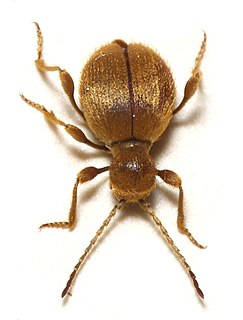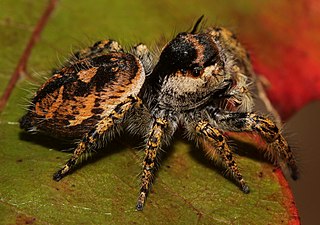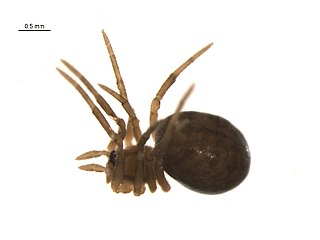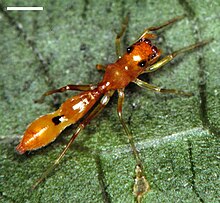
Lampshade spiders, family Hypochilidae, are among the most primitive of araneomorph spiders. There are two genera and twelve species currently recognized. Like mygalomorphs, most hypochilids have two pairs of book lungs, but like araneomorphs they have intersecting fangs, with the exception of some species which have chelicerae in an angle that is neither orthognathous or labidognathous. These long-legged spiders build typical "lampshade" style webs under overhangs and in caves. In the United States the fauna is primarily associated with the Appalachian, Rocky and California Mountains. Ten of the known species are found in these ranges, all in the genus Hypochilus. The genus Ectatosticta is found in China.
Masteria is a genus of curtain web spiders that was first described by L. Koch in 1873. They occur in the tropics of Central to South America, Asia and Micronesia, with one species found in Australia. M. petrunkevitchi males are 4 millimetres (0.16 in) long and females are 5 millimetres (0.20 in) long. M. lewisi, M. barona, and M. downeyi are slightly smaller and have only six eyes.

Spider beetles make up the subfamily Ptininae, in the family Ptinidae. There are approximately 70 genera and 600 species in the subfamily, with about 12 genera and 70 species in North America north of Mexico.

Simonellini is a tribe of spiders belonging to the Amycoida clade of the subfamily Salticinae of the family Salticidae. The group has been treated at a variety of formal and informal ranks, with different circumscriptions, including as the subfamilies Synemosyninae and Simonellinae. Its species mimic ants and beetles.
Tivyna is a genus of cribellate araneomorph spiders in the family Dictynidae, and was first described by R. V. Chamberlin in 1948.
Metriocampa is a genus of two-pronged bristletails in the family Campodeidae. There are about six described species in Metriocampa.
Pardosa tesquorum is a spider in the genus Pardosa, in the family Lycosidae . The distribution range of Pardosa tesquorum includes Russia, Mongolia, China, the USA, and Canada.

Phidippus arizonensis is a spider in the family Salticidae, in the infraorder Araneomorphae . The distribution range of Phidippus arizonensis includes the United States and Mexico.
Micaria rossica is a spider in the family Gnaphosidae, in the infraorder Araneomorphae . The distribution range of Micaria rossica includes North America, Europe, Turkey, Caucasus, Russia to Central Asia, and China.
Reo eutypus is a spider in the family Mimetidae, in the infraorder Araneomorphae . It is found in the USA.

Parasteatoda tabulata is a cobweb spider first described by female found by H. W. Levi in 1980. It originates from tropical Asia, but has been introduced to North America, Europe, and temperate Asia including China, Korea, and Japan.
Sosticus insularis is a spider in the family Gnaphosidae, in the infraorder Araneomorphae . The distribution range of Sosticus insularis includes the USA and Canada.
Philodromus anomalus is a spider in the family Philodromidae, in the infraorder Araneomorphae . It is found in the USA.

Theridion pennsylvanicum is a spider in the family Theridiidae, in the infraorder Araneomorphae . The distribution range of Theridion pennsylvanicum includes the USA and Canada.
Geolycosa rafaelana is a spider in the genus Geolycosa, in the family Lycosidae . It is found in the USA.
Physocyclus californicus is a spider in the family Pholcidae, in the infraorder Araneomorphae . The distribution range of Physocyclus californicus includes the USA and Mexico.
Litopyllus temporarius is a spider in the family Gnaphosidae, in the infraorder Araneomorphae . It is found in the USA.
Trochosa abdita is a spider in the family Lycosidae, in the infraorder Araneomorphae . It is found in the USA.

Enoplognatha intrepida is a spider in the family Theridiidae, in the infraorder Araneomorphae . The distribution range of Enoplognatha intrepida includes the USA, Canada, Greenland, and Korea.

Synemosyna formica, is an ant-mimicking jumping spider in the family Salticidae. It is found in the eastern United States and parts of Canada.








